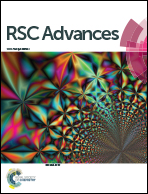Fully transient electrochemical testing strips for eco-friendly point of care testing†
Abstract
With the growing number of patients suffering from noninfectious chronic diseases, the consumption of point of care testing strips increases exponentially, particularly blood glucose testing strips, causing an increasingly severe conflict between strip recycling and the environment. In this paper, fully transient electrochemical strips are developed as a substitute for non-degradable strips. Proper explorations were made, including finding out suitable degradable substrates for strip-making among different degradable materials and optimization of degradable conducting paste. Taking advantage of dissolvable polymer-based materials and nontoxic carbon materials, the transient strips have validated electrochemical functionality to determine physiological levels of glucose with a sensitivity of 14.33 μA mM−1 cm−2 (correlation coefficient R2 is 0.99498) and reached full-degradation within a week after disposal. The interference experiment (negligible interference current response under 7%) and recovery tests (recovery ratio ranging from 92.46% to 102.47%) have illustrated its practical application in real sample detection. Such degradable-characterized testing strips can be widely used in chronic disease management with daily eco-friendly point of care testing, without potential pollution to the environment.



 Please wait while we load your content...
Please wait while we load your content...